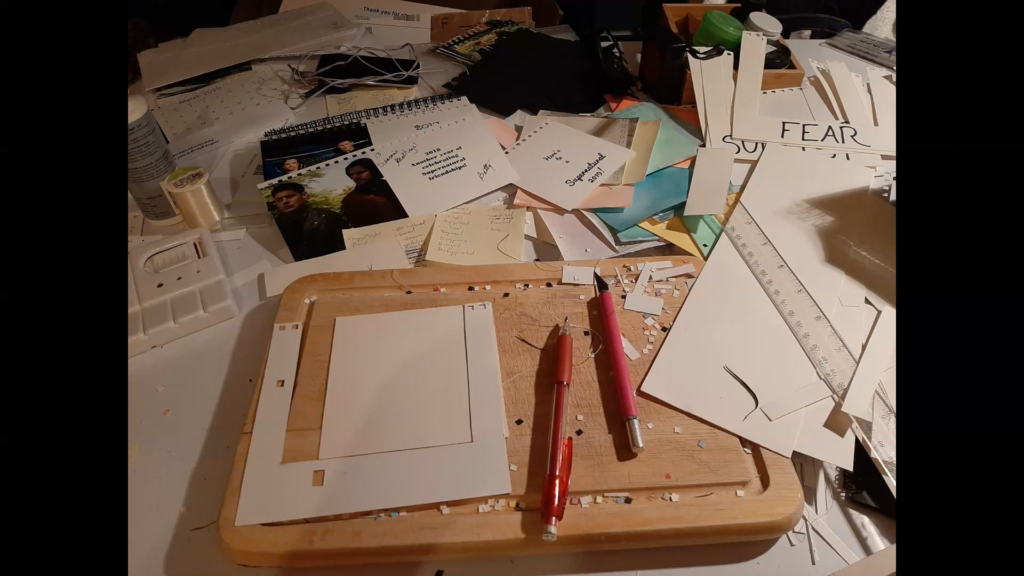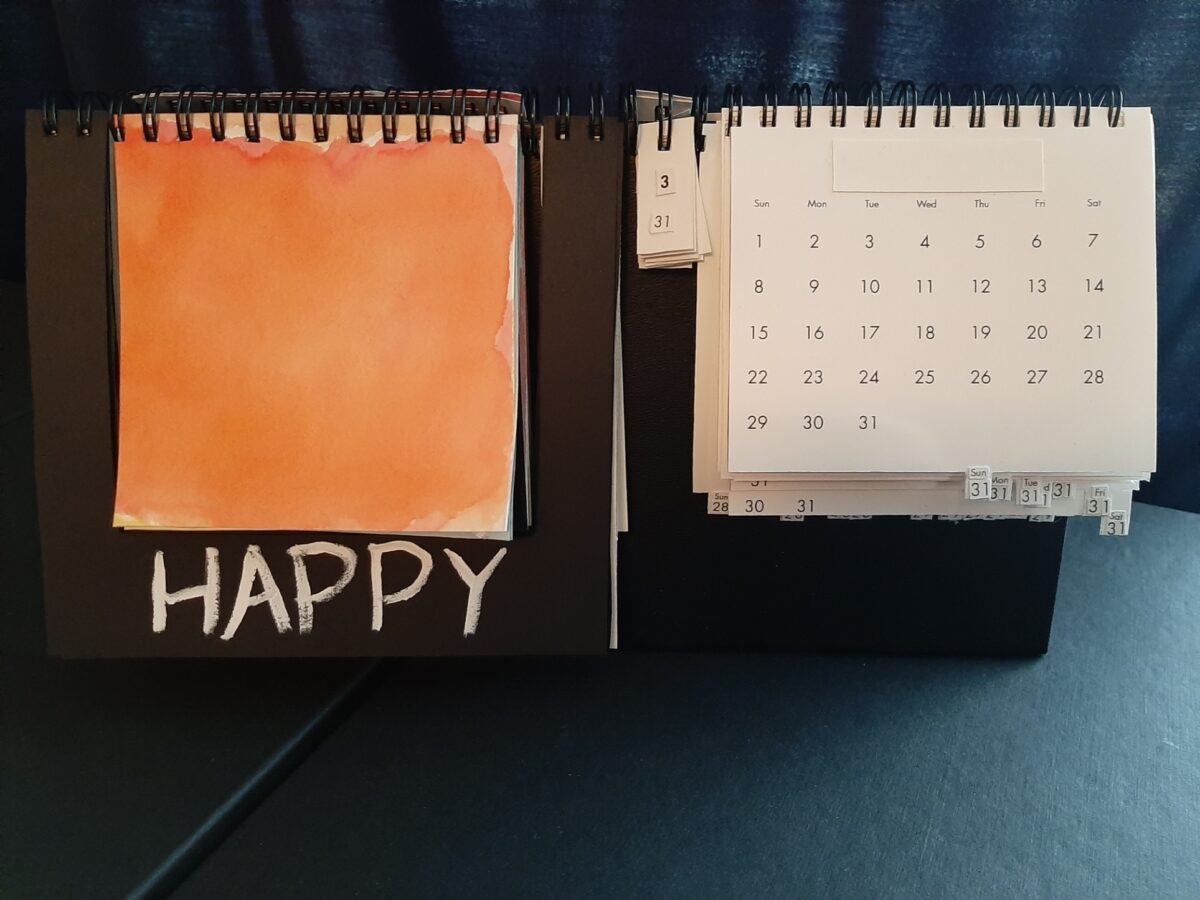Creator: K. Alix Antilla
Exhibition: It’s a Date
Published: February 2022
Format: Calendar, sculpture/tool
Content Advisories: None

Description of the Work
My project is two-fold. On the right side, a calendar that you can use every single year, months are denoted by how many days they contain and what day they start on. Rather than flip a page at a time forward, you flip to the month you need. A tracker to the left allows you to keep track of which month of the year it is. It does not track years and requires you to know whether or not it is a leap year. I found this part of the project to be a great contemplation on waste and what actually needs to be tracked day to day for the average person and why.
On the left side, I imagined a calendar of emotions – not something that records time, but something prescriptive, similar to a holiday calendar – only in an imagined culture where you are meant to feel certain emotions at certain times, regardless of how you actually feel. Similar to the more traditional calendar we know, this calendar you flip in sequence, the shortest period of time you have to flip a segment is 1 day. The calendar has 3 segments that work in sequence to bring you through 6 broad emotion categories that repeat twice before you are able to set the calendar back at the beginning and begin the process again. Despite being loosely divided in 12, the calendar is not meant to fit into the Julian calendar and can rotate independent of the seasons.
Both calendars were made using, in part, ready-made Supernatural (CW TV series) calendars that are made by a friend of mine every year since 2016 and given to me for Christmas. The calendar of emotions also uses watercolour, paper, and ink.
Artist Statement
Alix: I explore history and culture in my work, with a particular fascination for the small details that shape cultures globally and the different ways in which we experience the world depending on time, location, and community. These cultures can be both real or imagined.
Curator’s question:
“You invented two different kinds of calendars that, the way I see it, would service very different kinds of cultures. Can you speculate on some of the traits you would expect to find in the hypothetical cultures that had developed these two calendars for their own use?”
For my any-year calendar, it would be a culture that had far fewer novelty calendars, that’s for sure, which is kind of ironic given that I actually absolutely love novelty calendars. I have a one-room apartment, and I tend to have five calendars, usually, at minimum.
One thing about the culture that would have the any or every year calendar, in the lack of novelty calendars in that culture, is the reduction of waste. One thing that I did contemplate a lot while I was making these calendars was the waste produced. I originally wanted to use the Supernatural calendars for this project because I honestly don’t know what to do with them when the year ends.
Do I strip them apart, recycle them, and make them into gifts? It’s kind of a weird thing. I could reuse them in seven or 11 or 13 years, or whatever the pattern is, but then that requires storing them, and I live in a small apartment. So I was thinking, well, I can use them for art. So in the course of making the calendar, I was contemplating the amount of waste we produce. Not having novelty calendars would mean less paper production, but also, in the process of making this, I decided at the end to document how much waste was left. And it still felt like I had produced more waste than I had used up things that would have been waste. Now mainly that was because I had decided to use watercolor paintings in the interest of saving time. A better way to do this than to use the calendars fully would be to evoke emotion through collage rather than colour. So, I took this photo of everything that was left over after I was done with my project.

For the culture that follows the cyclical, emotional calendar, what intrigued me the most was thinking about different traits that culture might have. It would, in a sense, be less honest in a sense, be more honest about emotions and how they affect our lives. If you’re forced to contemplate an emotion when you’re not feeling it, does that give you more empathy towards people who are feeling that? How does that affect your day, just on the individual level? I had questions like that.
On the grander societal level, I had ideas about things like what kind of laws get made in, let’s say, the month of anger.
What kind of laws are made during the time of love?
What does a society do in a week of disgust?
Questions like that.
I thought it would bring to light the reasons behind our decisions. I think a lot in our own (western) culture, there’s this sort of underlying idea; I find that rationality or making decisions based on pure logic and political emotions is the pinnacle of evolution in how we should live our lives and then rule our lands. In stories like Star Trek, you have the Vulcans, who are usually portrayed as or seen as superior humans or are superior to humans because they operate on logic and not emotion, and they don’t have this clouded vision of things. Of course, that’s often juxtaposed with spontaneity, somebody making an emotional decision, and the emotional way presented as being the better way. But for the most part, people see the Vulcans as what we should strive towards. And I don’t know if that’s necessarily the correct way to view the world because I think when we strive for that — we’re not that person. It just ends up with us all acting on this sort of false pretense that our emotions aren’t dictating every single action we take, which they are; we’re just really good at rationalizing. So again, when I come back to the questions, you know, what laws are made in anger and what laws are made in happiness?
It’s going to be more apparent with the decisions you make that it’s the emotion that’s ruling the decision. Now, mind you for talking about humans, there could still be deceit there because, you know, you could be in the month of happiness, and you are miserable. You could be saying that you’re making this decision out of happiness, but you’re making it out of sadness. So maybe it wouldn’t be different than now. But it was fun to think of different ideas.
I think no matter what a culture followed, an emotional calendar would have a more open conversation about what that implied. They’d have more knowledge about what fear did to their lives, what sadness is caused, what disgust means, and how that affects their interpersonal relationships. And how would that translate to culture and laws?
I also think it would be extremely annoying to have your emotions dictated to you because, you know, trying to be happy when you’re sad, or trying to act sad when you’ve just had the greatest day of your life, and everything’s going great, and you’ve got to sit around and mope, like, that’s not how you want to spend your day! So it’d be a really interesting kind of dictatorship. It is extremely oppressive but also oddly freeing at times, and it would probably vacillate greatly between those two extremes. So yeah, it was an interesting exercise to think about.
